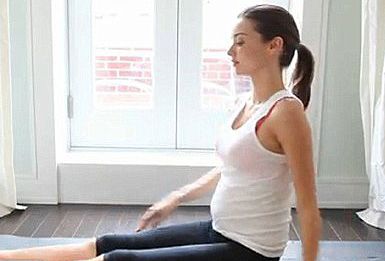Miranda Kerr has proved it's possible to maintain fitness while expecting - new footage for her skincare line shows the model practicing yoga four months into her pregnancy.
"You can pretty much do what you did before," LA Fitness personal trainer Natasha Barot tells us. "What you shouldn’t do is seek to improve fitness levels or improve or change your body shape. "Exercise during pregnancy should be used to maintain fitness and strengthen your body against problems that can occur," she explains. "The hormone, relaxin, increases flexibility which particularly affects the pelvis and hips increasing the chance of dislocation.
"Some muscles – such as the abs, glutes, hamstrings – elongate which makes them weaker, while some – particularly around the back, side and chest – shorten, which makes them tighter."
"And be careful because your point of gravity shifts as your bump grows which affects balance and posture, and blood sugar levels change making you more prone to dizziness and fainting," Natasha points out. So use stable surfaces and avoid exercise that requires balancing on one leg.
Eat two hours before, drink plenty of water, and make sure your environment is cool, she instructs. And, on a scale of one to 10, keep exertion around four to five so you’re only slightly out of breath, slightly warm, and could still maintain a conversation. Never exercise to exhaustion, she warns. "If you’re used to exercising with weights, don't forget to breathe in on contraction and out on exertion, to make sure you're getting enough oxygen and support the spine," she adds.
But start with the lightest weight and work your way up to avoid over-exertion. "Keep the resistance light, but the repetitions high – so two to three sets of 15-20 reps," Natasha adds.
She also warns not to lift weights above the head as it can increase blood pressure. The extra weight of pregnancy will put more pressure on your back so be extra careful with that part of your body. "And don’t exercise lying on your back at all past the first trimester as pressure on the spine increases," Natasha adds.
Pilates and yoga are traditionally thought of as ideal pregnancy exercises – as illustrated by Miranda - but Natasha warns against over-exertion and over-extension on stretches because the body is already increasing in flexibility. They do help with breathing, though, which is great preparation for the birth itself and can improve the strength of the pelvic floor muscles.
Do make sure you tell you tell staff at your gym or workout studio that you're pregnant and consult your doctor before embarking on an exercise regime.









